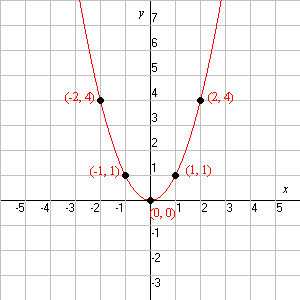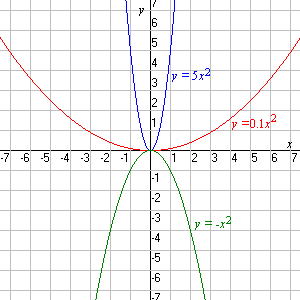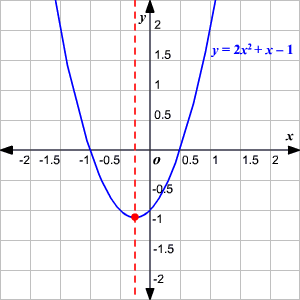how to find the range of a parabola
Quadratic Function
The general form of a quadratic function is . The graph of a quadratic function is a parabola , a type of -dimensional curve.
The "basic" parabola, , looks like this:

The function of the coefficient in the general equation is to make the parabola "wider" or "skinnier", or to turn it upside down (if negative):

If the coefficient of is positive, the parabola opens up; otherwise it opens down.
The Vertex
The vertex of a parabola is the point at the bottom of the " " shape (or the top, if the parabola opens downward).
The equation for a parabola can also be written in "vertex form":
In this equation, the vertex of the parabola is the point .

You can see how this relates to the standard equation by multiplying it out:
The coefficient of here is . This means that in the standard form, , the expression
gives the -coordinate of the vertex.
Example:
Find the vertex of the parabola.
Here, and . So, the -coordinate of the vertex is:
Substituting in the original equation to get the -coordinate, we get:
So, the vertex of the parabola is at .
The Axis of Symmetry
The axis of symmetry of a parabola is the vertical line through the vertex. For a parabola in standard form, , the axis of symmetry has the equation
Note that is also the -coordinate of the vertex of the parabola.
Example:
Find the axis of symmetry.
Here, . So, the axis of symmetry is the vertical line

Intercepts
You can find the -intercept of a parabola simply by entering for . If the equation is in standard form, then you can just take as the -intercept. For instance, in the above example:
So the -intercept is .
The -intercepts are a bit trickier. You can use factoring , or completing the square , or the quadratic formula to find these (if they exist!).
Domain and Range
As with any function, the domain of a quadratic function is the set of -values for which the function is defined, and the range is the set of all the output values (values of ).
Quadratic functions generally have the whole real line as their domain: any is a legitimate input. The range is restricted to those points greater than or equal to the -coordinate of the vertex (or less than or equal to, depending on whether the parabola opens up or down).
how to find the range of a parabola
Source: https://www.varsitytutors.com/hotmath/hotmath_help/topics/quadratic-function
Posted by: allenappe1965.blogspot.com

0 Response to "how to find the range of a parabola"
Post a Comment